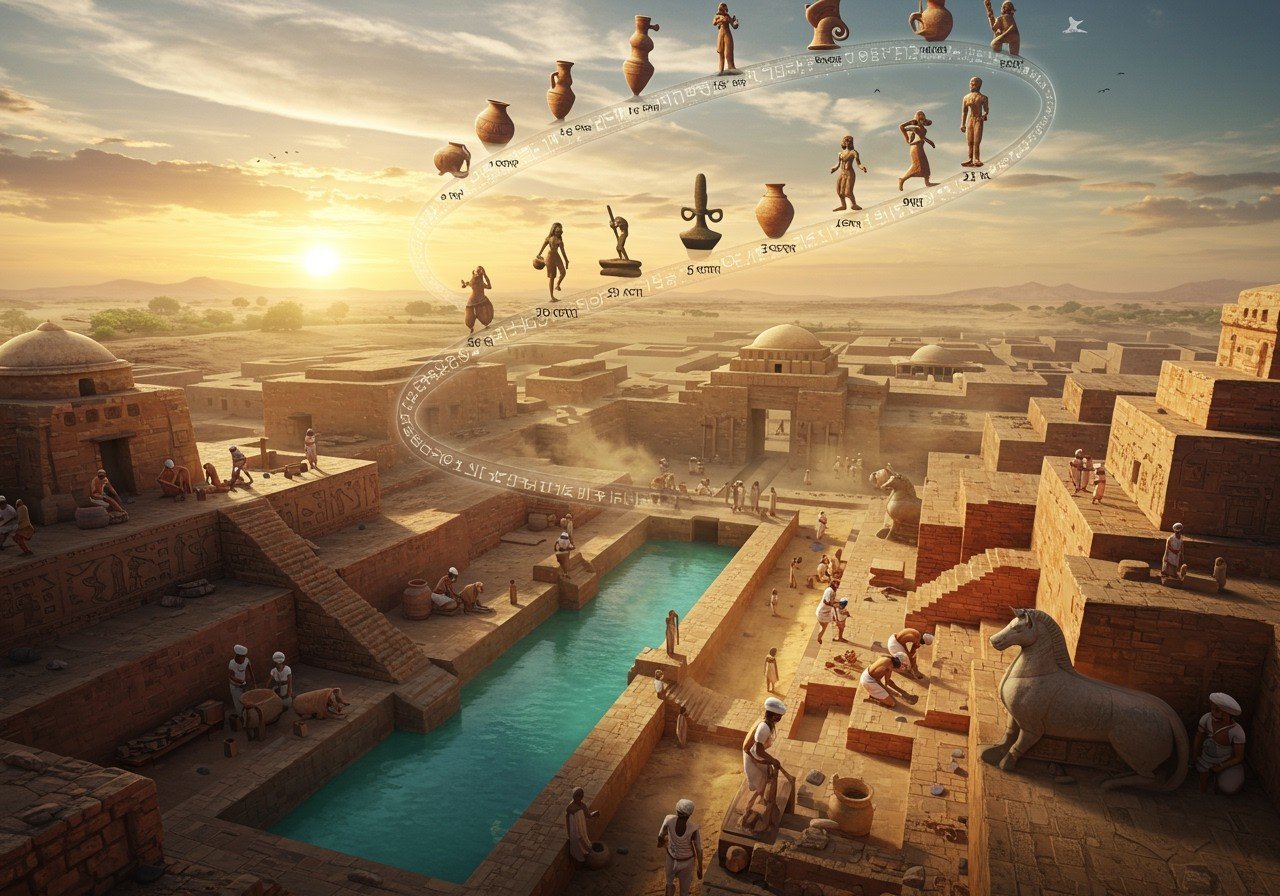
The Indus Valley Civilization, also known as the Harappan Civilization, stands as a testament to human ingenuity and resilience. Flourishing between approximately 7000 BCE and 600 BCE in the northwestern regions of the Indian subcontinent, this Bronze Age civilization left an indelible mark on history. This article delves into the civilization’s period, age, and timeline, offering a comprehensive overview for those intrigued by India’s rich cultural heritage.
Defining the Indus Valley Civilization Period
The Indus Valley Civilization’s timeline is categorized into distinct periods:
- Early Harappan Phase (7000-3300 BCE): This era witnessed the development of early farming communities and the establishment of religious practices. Settlements gradually transitioned from nomadic lifestyles to settled agriculture, laying the groundwork for future urban development. This period signifies the initial stages of the civilization’s formation.
- Mature Harappan Phase (3300-1900 BCE): This period marks the civilization’s peak, characterized by sophisticated urban centers like Harappa, Mohenjo-daro, and Dholavira. Advanced urban planning, extensive trade networks, and complex social structures emerged during this time. The Mature Harappan phase showcases the civilization’s remarkable achievements in urban development and governance.
- Late Harappan Phase (1900-600 BCE): This era reflects a period of decline, attributed to factors like climate change and shifts in river patterns. Urban centers gradually diminished, and the civilization’s influence waned. Archaeological evidence suggests adaptations and migrations during this challenging period.
Unveiling the Indus Valley Civilization Age
The Indus Valley Civilization’s age is marked by significant advancements:
- Technological Prowess: Standardized weights and measures facilitated trade and economic stability. Advanced drainage systems and impressive urban planning demonstrated sophisticated engineering skills. Metallurgy played a vital role, with evidence of copper, bronze, and gold artifacts.
- Social Organization: Evidence suggests a relatively egalitarian society, with uniform city layouts and housing structures. This contrasts with contemporary civilizations with more pronounced social hierarchies, raising intriguing questions about social dynamics.
- Indus Script: The undeciphered Indus script remains a mystery, hinting at advanced communication and administrative systems. Researchers continue to study these symbols, hoping to unlock the secrets of their language and culture.
- Trade Networks: Extensive trade networks connected the Indus Valley with regions like Mesopotamia, fostering economic growth and cultural exchange. The discovery of Indus seals in Mesopotamian cities confirms the existence of these far-reaching trade routes.
- Religious Practices: Seals depicting animals and deities suggest a rich spiritual life. Religious practices likely revolved around nature and fertility, reflecting the importance of agriculture in their society. Further research may illuminate the specific beliefs and rituals of this ancient civilization.
Tracing the Indus Valley Civilization Timeline
Key events and developments in the Indus Valley Civilization’s timeline:
- 7000 BCE: Emergence of early farming communities, marking the transition to settled agriculture and the foundation of the civilization.
- 6000-3000 BCE: Development of religious practices and rituals, often centered around nature and fertility.
- 3300 BCE: Beginning of the Early Harappan period, with the emergence of small farming villages.
- 2600 BCE: Start of the Mature Harappan period, characterized by the rise of major cities like Harappa and Mohenjo-daro.
- 2500 BCE: Significant achievements in urban planning, agriculture, and trade, showcasing the civilization’s peak.
- 1900 BCE: Commencement of the Late Harappan period, marked by decline and adaptation to changing environmental conditions.
- 600 BCE: The generally accepted end of the Indus Valley Civilization in its recognizable form, although its cultural influence persisted.
Notable Archaeological Sites
- Harappa: Early evidence of urban planning and trade, revealing organized streets and buildings.
- Mohenjo-daro: Advanced drainage systems and city layouts, including the Great Bath, a significant architectural feat.
- Dholavira: Unique water management systems, including reservoirs and dams, demonstrating sophisticated engineering skills.
Connecting with Ancient Heritage through Poojn.in
Poojn.in, India’s largest Dashakarma bhandar, offers a unique opportunity to connect with the spiritual legacy of the Indus Valley Civilization. We provide authentic ritual items and religious artifacts, allowing you to honor ancient traditions in your modern practice.
Explore our collection, including:
- Copper and brass items, reminiscent of those used in Indus Valley rituals. Discover our selection here.
- Traditional clay lamps (diyas), reflecting ancient worship practices. Find your diyas here.
- Items for Lord Shiva worship, a deity revered during the Indus period. Explore our Shiva collection.
Conclusion
The Indus Valley Civilization remains a source of fascination and inspiration. Its sophisticated urban planning, technological advancements, and enduring cultural influence continue to resonate with us today. By understanding its history, we gain a deeper appreciation for our shared human heritage.


